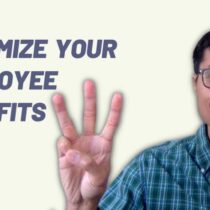
What are stock options?
Stock options represent the right to buy company stock at a fixed price (“exercise price”) during a fixed time period (usually 10 years).
Stock options are a form of compensation. You don’t have to exercise your stock options if you don’t want to. But since stock prices tend to go up over time, you usually end up with the option to buy your company’s stock at a lower price. It’s what I call “instant profit.”
How do stock options work?
If your company is giving you stock options, they will give you a written grant letter explaining the terms. You will need to sign this agreement to accept the grant. The stock options grant letter will state:
- Type of Options Award: This can either be an incentive stock option (ISO) or a non-qualified stock option (NSO).
- Date of Grant: The date when your stock options grant will be made effective. This is important when computing taxes for incentive stock options.
- Option Price per Share: This is the price that you can buy the company stock for at a future date, should you decide to exercise this option.
- Total Number of Shares Under Option: This is the total number of company shares that you will have the option to purchase.
- Vesting Schedule: The series of dates when your stock option vests and become exercisable, along with the number of shares that vests on each date. Stock options usually vest over three, four or five years.
- Expiration Date: Stock option grants usually expire after 10 years.
What are the two types of stock options?
The two types of stock options are non-qualified stock options (NSOs) and incentive stock options (ISOs). ISOs have better tax benefits than NSOs, but have more restrictions attached to it.
- What are non-qualified stock options (NSOs)?Non-qualified stock options (NSOs) are stock options that do not qualify for special tax treatment. You will have to pay ordinary income taxes once you exercise the stock option.In the example above, if you exercise your NSO on January 1, 2023 and buy The Cheesecake Factory stock at the exercise price ($40) and the stock price then is $50 (fair market value), then you have to pay ordinary income tax on the spread: the difference between the fair market value and the exercise price. In this case, the spread is $10 per share, and if you buy 250 shares, you have to pay ordinary income taxes on $2,500.
- What are incentive stock options (ISOs)?Incentive stock options (ISOs) are stock options that qualify for special tax treatment. You don’t have to pay ordinary income taxes once you exercise the stock option. If you hold the stock for at least a year after purchase before selling, then you only have to pay long-term capital gains tax, which is lower than ordinary income taxes.Long-term capital gains tax rates for most middle/upper middle class Americans is 15%, and ordinary income tax rates for most middle/upper middle class Americans is 24% or 32%.In the example above, if you exercise your ISO on January 1, 2023 and buy The Cheesecake Factory stock at the exercise price ($40) and the stock price then is $50 (fair market value), no taxes are due.
If you decide to sell the stock on February 1, 2024 (you’ve held it for more than a year), and the stock price then is $55, you have to pay capital gains tax on your stock price gains, which is $15 per share ($55 less your $40 exercise price).
Why do companies give stock options?
Companies give stock options to incentivize their employees to stay longer. It costs money for a company to hire and train new staff, so they don’t want you to leave. Stock options vest over several years, and they tend to increase in value over time since stock prices generally rise over long periods. Because of this, the employee has an incentive to stay and wait to exercise those stock options to get additional money.
Stock Options Lifecycle
Stock options go through the following six lifecycle stages, regardless of whether they’re ISOs or NSOs.
- Grant: You are awarded an option grant through an options agreement. It will contain your exercise price, total number of shares you can buy, and the vesting schedule.
- Plan: Stock prices will swing wildly, so it’s best to have a plan in advance. In what circumstance will you exercise your option? When will you sell the stock? What will you do with the proceeds?
- Vest: Stock options can vest every year for over 4-5 years. A common vesting schedule is 25% after one year, and then monthly or quarterly thereafter.
- Exercise: Once it vests, you now have the right (not requirement) to purchase company stock at the exercise price. If the current stock price is higher than your exercise price, then it’s usually profitable to exercise your stock option. It’s like buying stock at a discount.
- Sell: At some point, you may decide to sell the stock according to your initial Plan. You can sell it immediately, wait for a year, or hold it for a long period. You may owe capital gains taxes upon sale.
- Use Proceeds: Will you use your proceeds for an upcoming vacation? For a vacation home? Or will you invest the proceeds in a diversified portfolio?
How do I know when to exercise stock options?
You may want to exercise your options if:
- Your options have value. Check the current company stock market price at Yahoo Finance. Check the exercise price in your options grant letter. This is the price you can buy the stock for. If the current stock price is greater than the exercise price, then you will be able to buy the stock at a discount. That’s instant profit for you.
- You have extra cash. If your option allows you to buy 1,000 shares of stock at $40 per share, you have to cough up $40,000 to complete the purchase. Do you have that cash? You don’t want to drain your bank account just to exercise your stock option. (Some companies allow a cashless exercise.)
- You understand the tax implications. If you exercise an NSO, you have to pay federal and possibly state/local taxes on the spread (difference between the current stock price and exercise price). If you’re in the 32% tax bracket, then be prepared to give about a third of your profit to Uncle Sam! If you’re exercising an ISO, no taxes are due at exercise but the spread is taxable for AMT purposes.
- You have a plan in place. What are you going to do after you’ve exercised your options? Will you hold or sell? It’s tempting to hold your company stock if you’ve seen the price continuously rise over the past years. But is that the best option? If you sell, what will you do with the proceeds? Is it time to buy that vacation cabin you’ve been dreaming about, or invest in a rental property or the stock market?
- Your stock options are about to expire. Elon Musk was awarded Tesla stock options in 2012 as part of a compensation plan. The 2012 award was for 22.8 million shares at an exercise price of $6.24 per share. Tesla shares closed at $1,089.01 on November 17, 2021, meaning his gain on the shares totals just under $25 billion. Musk’s options expire in August of 2022, so he will have to exercise his options before then to get all that money.
How are stock options taxed?
Incentive stock options (ISOs) are taxed differently from non-qualified stock options (NSOs).
For ISOs, no taxes are due when the options are granted and when they vest. No taxes are due when they are exercised, but the spread (fair market value less exercise price) is taxable for AMT purposes. If you hold the stock for at least a year after purchase, you pay long-term capital gains taxes on the sale price less the exercise price.
For NSOs, no taxes are also due when the options are granted and when they vest. When you exercise the NSO, you pay ordinary income taxes on the difference between the fair market value and the exercise price. You pay capital gains tax on the sale price less the fair market value.
Are stock options risky?
Trading open market stock options is extremely risky. You can win a ton of money, but you can also lose a lot of money. It’s like gambling.
If you buy a call option, and the stock price increases by 2.5%, the value of your call option might increase by 25%. Huge gains! But if the stock price declines by 9%, your call option might plummet by 90%… ouch! You can see the same wild swings with buying put options.
If you sell a call or a put option, you can get a little bit of income. Usually you’re selling options way out of the money, meaning there’s a low likelihood that the other party will be able to exercise it. But if that 5% or 10% chance happens, you’re toast.
Selling options for income is like picking up free quarters on the road, while a steamroller is right behind you.



Comments are closed.